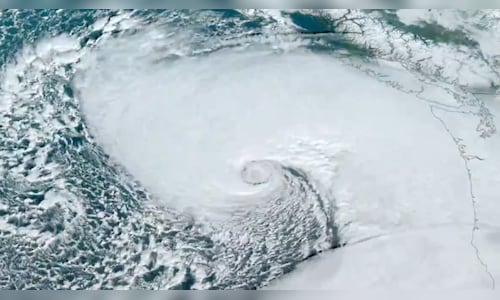
Storm’s development and expected path
The India Meteorological Department (IMD) has provided an update that Cyclone Fengal, currently classified as a deep depression, is situated near latitude 9.1°N and longitude 82.1°E, approximately 110 km east-northeast of Trincomalee, Sri Lanka, and 310 km southeast of Nagapattinam, Tamil Nadu.
The system is expected to continue moving north-northwest, skirting Sri Lanka’s coast before heading toward the Tamil Nadu-Puducherry region. The IMD forecasts that the system will intensify into a cyclonic storm with wind speeds reaching 65–75 kmph, gusting up to 85 kmph, as it nears the coastline.
Authorities have issued orange and yellow alerts for several districts in Tamil Nadu, including Chennai, Kancheepuram, Chengalpattu, Villupuram, and Cuddalore, where heavy to very heavy rainfall is expected from November 28.
Additionally, red alerts have been declared for the Andhra Pradesh districts of Tirupati and Nellore for November 29, with very heavy to extremely heavy rainfall predicted.
Cyclone Fengal’s expected impact in Tamil Nadu
As the storm moves closer to the Tamil Nadu coast, significant weather disruptions are anticipated. Coastal districts, including Chennai and Cuddalore, are already experiencing moderate to heavy rainfall.
The IMD has also warned of rough seas and waves over 10 feet, which will affect fishermen and coastal activities. Local authorities have initiated evacuation and safety measures, particularly in low-lying and vulnerable areas along the coast.
In Cuddalore, one of the most affected districts, residents in low-lying areas were shifted to relief shelters as heavy rainfall and flooding caused widespread disruptions. Likewise, in Nagapattinam, around 1,200 people from flood-prone areas were relocated to shelters for their safety. The state has issued precautionary measures, with shelters, food, water, and medical supplies being prepared for those impacted by the storm.
Indian Navy’s disaster response measures
In response to the growing threat posed by Cyclone Fengal, the Indian Navy’s Eastern Naval Command has activated its disaster relief operations. Working alongside the Tamil Nadu and Puducherry Naval Area, the Navy has been mobilising resources for humanitarian assistance, including flood relief teams, diving units, and helicopters for rapid deployment.
Emergency supplies such as food, water, medical provisions, and other relief materials have been stockpiled and are ready to be distributed as the storm approaches. The Indian Navy’s Flood Relief Teams are on high alert and will be deployed for Search and Rescue (SAR) operations in the affected areas.
Warnings and advisories for fishermen and residents
With the intensification of the storm, the IMD has issued stern warnings for fishermen in the region. A “no-fishing” advisory has been issued for the Tamil Nadu and Andhra Pradesh coasts, urging them to stay ashore due to the dangerous sea conditions.
Fishermen Warning 28.11.2024 pic.twitter.com/YQ7ptq6TkZ
— tnsdma (@tnsdma) November 28, 2024
Additionally, authorities have advised residents in vulnerable coastal regions to stay indoors, avoid travel, and follow safety instructions from local authorities.
The IMD has also recommended the securing of property and infrastructure, especially in low-lying areas prone to flooding.
Impact of the storm in Sri Lanka
Before heading towards India, Cyclone Fengal affected Sri Lanka, where over 250,000 people were displaced due to severe flooding caused by torrential rains from the storm system.
At least four children have been confirmed dead, having drowned in flash floods, and several other people remain missing. Authorities in Sri Lanka are continuing search and rescue operations.
Cyclone Fengal: Key Facts
- Current status: Deep depression, expected to intensify into a cyclonic storm
- Expected landfall: Between Karaikal and Mahabalipuram, Tamil Nadu, around the morning of November 30
- Wind speeds: 65–75 kmph, gusting to 85 kmph
- Impact areas: Tamil Nadu, Puducherry, Andhra Pradesh, Sri Lanka
- Alerts issued: Orange, yellow, and red alerts for affected regions
- Indian Navy’s role: Disaster response, flood relief, and search and rescue operations



